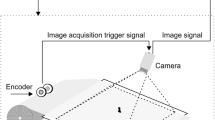Abstract
This paper describes an adaptive image-segmentation method based on a simplified pulse-coupled neural network (PCNN) for detecting fabric defects. Defect segmentation has been a focal point in fabric inspection research, and it remains challenging because it detects delicate features of defects complicated by variations in weave textures and changes in environmental factors (e.g., illumination, noise). A new parameter called the deviation of the contrast (DOC) was introduced to describe the contrast difference in row and column between the analyzed image and a defect-free image of the same fabric. The DOC essentially weakens the influence of the weave texture and the illumination. The simplification of PCNN reduces the number of the network’s parameters by utilizing the local and global DOC information for the parameter selections. The validation tests on the developed algorithms were performed with fabric images captured by a line-scan camera on an inspection machine, and with images from TILDA’s Textile Texture Database (http://lmb.informatik.uni-freiburg.de/research/dfg-texture/tilda) as well.
Similar content being viewed by others
References
Li, L.Q., Huang, X.B.: Recent studies on image-based automatic fabric inspection system. J. DongHua Univ. 28(4), 118–122 (2002)
Conci, A., Procenca, C.B.: A comparison between image-processing approaches to textile inspection. J. Textile Inst. 91(2), 317–323 (2000)
Kuo, C.F., Lee, C.J., Tsai, C.C.: Using a neural network to identify fabric defects in dynamic cloth inspection. Textile Res. J. 73(3), 238–244 (2003)
Chen, J.J., Xie, C.P.: Fabric detection technique based on neural network. Textile Res. J. 27(4), 36–39 (2006)
Zhang, Y.F., Bresee, R.R.: Fabric defect detection and classification using image analysis. Textile Res. J. 65(1), 1–9 (1995)
Chetverikov, D., Hanbury, A.: Finding defects in texture using regularity and local orientation. Pattern Recogn. 35, 203–218 (2002)
Sezer, O.G., ErtEE, A., Eril, A.: Using perceptual relation of regularity and anisotropy in the texture with independent components for defect detection. IEEE Pattern Recogn. 40(1), 121–133 (2007)
Cohen, F.S., Fan, Z., Attali, S.: Automated inspection of textile fabrics using textural models. IEEE Trans. Pattern Anal. Machine Intell. 3–8, 803–808 (1991)
Meylani, R.: 2-D Iteratively reweighted least squares lattice algorithm and its application to defect detection in textured images. EIEICE Trans. Fundam. Electron. Communi. Computer Sci. E 89(A5), 1484–1494 (2006)
Jasper, W.J., Potlapalli, H.: Image analysis of mispicks in woven fabric. Textile Res. J. 65(11), 683–692 (1995)
Jasper, W.J., Gamier, S.J., Potlapalli, H.: Texture characterization and defect detection using adaptive wavelets. Optical Eng. 35(11), 3140–3149 (1996)
Fusheng, Y.: Engineering Analysis and Application based on Wavelet Transform, pp. 32–69. Science Press, Beijing (2000)
Li, L.Q., Huang, X.B.: Woven fabric defect detection with features based on adaptive wavelets. J. DongHua Univ. 27(4), 82–87 (2001)
Shi, M.H., Zhang, J.Y.: Fabric’s defect detection based on improved PCNN. Silk 6, 14–17 (2002)
Johnson, J.L., Padgett, M.L.: PCNN models and applications. IEEE Trans. Neural Netw. 10(3), 80–498 (1999)
Kuntimad, G., Ranganath, H.S.: Perfect image segmentation using pulse-coupled neural networks. IEEE Trans. Neural Netw. 10(3), 591–598 (1999)
Workgroup on Texture Analysis of DFG. TILDA Textile Texture Database: http://lmb.informatik.uni-freiburg.de/research/dfg-texture/tilda
Liu, J.Z., Li, W.Q.: The automatic thresholding of gray-level pictures via two-dimensional Otsu method. Acta Automat. Sinica 19(1), 101–105 (1993)
Ge-xian, H., Du-yan, B.: Evaluation methods for image segmentation. J. Image Graph. 5(1), 39–43 (2000)
Zhang, Y.J.: Image Segmentation, pp. 149–169. Science Press, Beijing (2001)
Author information
Authors and Affiliations
Corresponding author
Rights and permissions
About this article
Cite this article
Shi, M., Jiang, S., Wang, H. et al. A Simplified pulse-coupled neural network for adaptive segmentation of fabric defects. Machine Vision and Applications 20, 131–138 (2009). https://doi.org/10.1007/s00138-007-0113-z
Received:
Revised:
Accepted:
Published:
Issue Date:
DOI: https://doi.org/10.1007/s00138-007-0113-z




